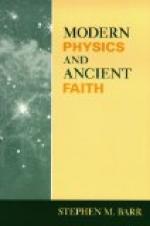“It is the key to the proper understanding of the universe.
“‘The squares of the times are as the cubes of the distance’ means that all motion is the result of two forces acting upon prakriti, and that where the two forces are balanced, or equal, the result in motion is a circle or ellipse, the square of the Repulsion being equal to the cube of the Attraction to make them equal and produce a circle. In other cases they produce hyperbola and parabola.
“This is a little dry—nearly all fundamental knowledge is—but the reward of patience is great.
“The orbital speed of the earth is about 60,000 miles per hour. The attraction of the sun exactly equals the repulsion created by the motion; more accurately, the speed created by the repulsion. The result of the two forces working together at exact balance is a circle. An ellipse is a circle bent a little, and the ellipse in which the earth actually moves comes from varying attraction and repulsion. Kepler’s second law covers that.
“If the orbital speed of the earth were a mile less per hour, or even a foot less, then the earth would wind up around the sun as a dog gets wound up with his chain around a tree. If this speed were a mile more per hour, then the earth would wind out, each year getting farther and farther away, until finally it would be lost. When the speed is exactly proportional to the pull—that is, when it is as 1.6 is to 2,—the result is a circular orbit, the eccentricity of which is caused by certain fluctuations in the attraction and repulsion.
“Suppose a planet were to be placed so that it would have a time of two years. Its distance from the sun would be 1.6 that of the earth. Why? Because to get the time doubled we would have to take the square root of 4; and to get the distance the cube root of the same number, 4. If you wish to be very exact the cube root is 1.5889, but 1.6 is near enough for all ordinary work.
“If you wanted to find out the distance of a planet revolving in six months you would divide the earth’s distance by 1.6.
“In proportion you get any time or distance you may desire with absolute accuracy. The distance of any planet from the sun gives its time, or its time gives its distance—when that of any of the others is known. This law applies throughout the universe; in everything and everywhere. It is not a law of orbital revolution alone, but a law of all motion.
“Our moon has a time of 29 days and a speed of about 50,000 miles per day. If the speed were greater it would leave us, if less it would wind up, falling to the earth in the form of a spiral.
“At what distance would it have to be to have a time of fourteen days? Divide 240,000 miles by 1.6. A seven-day moon, would be 1.6 that distance. And the exact distance for a one-day moon, for a moon that would always be in the same place in the heavens, moving as the earth revolved on its axis, would be about 24,998 miles.




